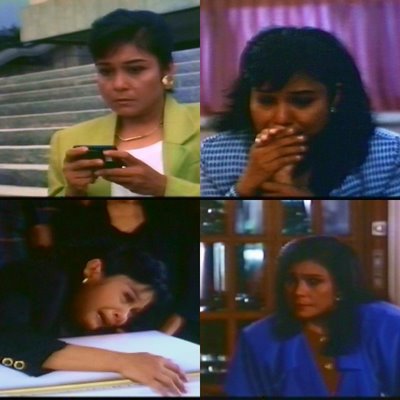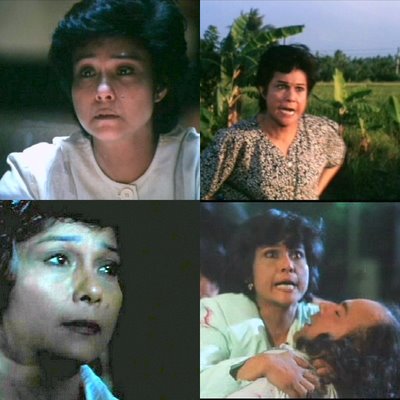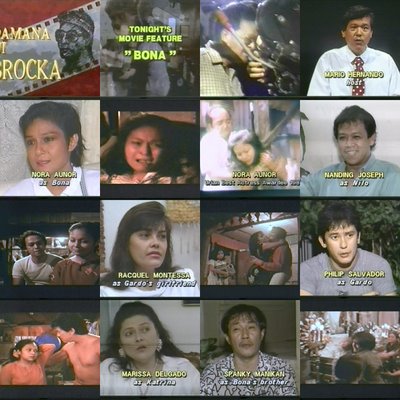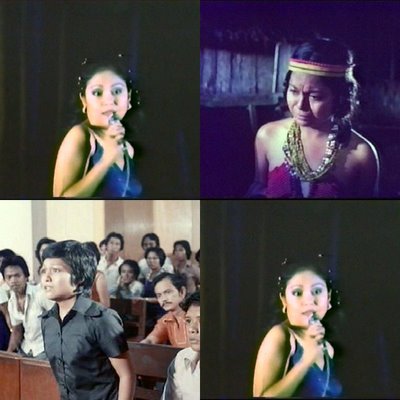BAKIT BUGHAW ANG LANGIT?
Noel Vera Reviews Mario O'Hara's Lost Masterpiece
(Please note: No print of this film is known to officially exist, even if it was made only twenty-four years ago, a sad commentary on the state of Film Preservation in the Philippines.)
Mario O'Hara's Bakit Bughaw ang Langit? (Why is the Sky Blue? 1981) opens by way of introduction with panoramic views of Manila. We see the arrival of Babette Gomez (Nora Aunor) at an apartment complex—or rather, the arrival of her family; movers unload a truckload of furniture and carry it into their newly rented apartment. O'Hara's camera watches as the family unpacks and settles in, and we come to know something about each by the way he or she acts within the camera frame--imperious Sofia (Anita Linda), bossing everyone around her; sullen Nardo (Mario Escudero), dutifully carrying out his wife's orders; beautiful Lorie, who barks like her mother, but at a lesser volume; quiet Babette, their other daughter, who hurries about doing most of the work along with the movers.
We meet the neighbors: Marta (Melly Mallari) who owns the "sari-sari" (grocery) store at the complex entrance; Cora (Alicia Alonzo) and her out-of-work husband Domeng (Rene Hawkins); Luring (Metring David) who sells clothes to neighbors as a sideline; Luring's son Bobby (Dennis Roldan), a mental cripple who likes to play basketball. Only Mang Jesus (Carpi Asturias), a courtly old gentleman, seems to notice Babette's plight; they talk about the little cacti she's raising, and she says something about them without any particular emphasis--that they flourish on very little care and water--that summarizes her life up to that point. Later, Luring offers Sofia some clothes, telling her story in the process--that she's raising Bobby by herself; that she's having a difficult time as she must work and can't bring her son along. Sofia has a proposal: instead of paying for the clothes, maybe Babette can go over every day and feed Bobby while Luring goes to work.
And so Babette finds herself with a plate of food at Luring's door, looking in (you think of young women in fairy tales peering into the monster's den, wondering at the silence). She finds Bobby upstairs, chained, sets the food before him; he sits hunched over the plate, eating with his fingers. Later, Babette asks Bobby for his basketball-- to clean it, she explains; Bobby gives it after some hesitation. For the first time in the picture, O'Hara cuts to a closeup— of Babette's face, then of Bobby's (before this, the film had been made up of long and medium shots). They have connected with each other.
I sketched the film's first third to give some idea of just how patiently O'Hara sets up the premise, building on detail after little detail, using a self-effacing, almost invisible storytelling style until before you know it an entire microcosm sits before you, the desires, needs, ambitions, and failures of its inhabitants glittering like so many constellations. This is Filipino drama at its most understated, where the yells and shrieks and chatter of the various characters fade into the background, and the relationship that forms between shy Babette and innocent Bobby takes center stage, simply and with little fuss. You could easily imagine the story being included in Dekalog, Krzysztof Kieslowski's ten-part housing development drama, only the characters speak Tagalog and the script (by Lydia Collantes Villegas and O'Hara) doesn't resort to the ironic twists or metaphysical in-jokes of Kieslowski's masterwork--it's life taken straight, no chaser.
Bakit Bughaw
doesn't have the overwhelming immediacy, the stench of street gutters found in perhaps the greatest Filipino film on urban realism, Lino Brocka's
Maynila sa Mga Kuko ng Liwanag (
Manila in the Claws of Neon, 1975), but it does have a distinct look, consistent with its theme and sensibility. Almost the entire film takes place inside the apartment complex, a series of buildings surrounding a large central courtyard; O'Hara makes you feel the massive scale of the buildings, the way they dwarf and dominate their inhabitants. With Jose Batac, Jr. (who did Brocka's classic
Tinimbang Ka Ngunit Kulang (
You Were Judged and Found Wanting, 1974) as cinematographer, O'Hara achieves a kind of visual bleakness, an unspectacular glow that seeps not so much from sunlight but from naked fluorescent tubes, or brutal arc lamps. O'Hara uses this light to shoot against barred windows or concrete walls, giving you little sense of greenery or open space; the overall impression is of a claustrophobic enclosure—a prison, in fact, one you reach by walking through a dark corridor, the entrance to which is flanked on one side by Marta's "sari-sari" store (it's a measure of O'Hara's mastery of space that you eventually have a good idea of the complex's layout). When at one point Bobby evades Babette and runs out that corridor to the outside world, it's as if he's attempting an escape; Babette chasing him down is like a convict chasing a fellow convict--she does so out of fear of reprisal. When she finds him, their laughter is an expression of merriment at the absurdity of their shared situation.
It's not just the prison metaphor; every once in a while, the community has this little ritual they hold what I like to call "the court of public opinion," where some quarrel or scandal spills out of one apartment, and everyone else pours out of theirs to enjoy the show. When, say, Cora screams at Domeng for bringing home his mistress to live with them, or when a serial rapist roaming the outside streets claims a new victim and the men blame hapless Bobby, the people line up in a rough circle around the yelling combatants, everyone giving their opinions at the same time, at full volume. The case is ultimately worked out to everyone's satisfaction (the winners brag, the losers blame someone else--in Cora's case the mistress), both parties as a result often suffer the same penalties--derision, laughter, utter shame.
Against this remarkably complex social context Bobby and Babette grow close. We have been with them from the tentative beginnings of their relationship, so we know what they have between them--that their affection grew out of mutual loneliness, out of Bobby's need for a surrogate mother to love him and Babette's need to pour love on something other than little pots of cacti. At the same time, O'Hara makes us aware of what the people around them are like, and we flinch in dread at the prospect of their being publicly exposed. Gossip has already spread; a gay hairdresser accuses Babette of caring for the handsome Bobby because she can't find a man otherwise; Marta's no-good son is attracted to Babette, jealous of Bobby. Even we wonder at the relationship: is Babette tempted to take advantage of Bobby? Would it be so wrong if he responded?
O'Hara handles all the issues with tact and delicacy, knowing full well that a misstep could easily lead to bathos. He's helped in no small measure by a terrific cast (Anita Linda, Metring David, and Mario Escudero, to name but a few), most of all by Aunor and Roldan in the lead roles.
O'Hara considers Roldan the finest Filipino actor alive; in this picture it's easy to see why. He has a freshness and modesty that's impossible to fake, and a direct link with the audience that keeps them on his side, no matter what he does (when Babette at one point orders him to strip and he does so right in front of her, the scene is made funnier by the fact that he clearly has no idea what effect his nakedness has on Babette).
Aunor by this time had already been called one of the Philippines' best actress, and for far showier performances. In Bakit Bughaw, she takes her archetypal role--the oppressed, dark-skinned little Filipina--and plays it with a simplicity and lack of consciousness that is, in a word, astounding. It's as if she invented the character on the spot, as if the role was really her, and that she had never played anything else before (which, if you've seen Ikaw ay Akin (You Are Mine, 1978), Fe, Esperanza, Caridad (1974) and Ina Ka ng Anak Mo (You Are The Mother of Your Son, 1979) among many others, you know isn't true at all). Aunor matches O'Hara's immense patience, gathering detail after detail until her character is as believable as any real person--is more believable than any mere person. You feel as if you knew someone like this, that this was perhaps based on (for all you know) your next-door neighbor (and that is one of O'Hara's secrets--that his characters are always based on someone he knew or met in one of his daily walks about Manila). This film, of which officially there is no print left in existence, is one of Aunor's finest performances, one of O'Hara's best works, and one of the great unknown--perhaps lost--treasures of Philippine cinema.


















